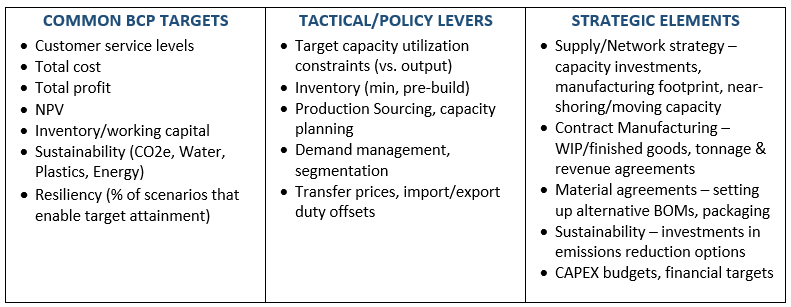For many, this combination of complexity and pressure stemming from BCP is, in turn, introducing anxiety and a sense of frustration. Fortunately, this doesn’t have to be the case. BCP is highly effective and delivers an exceptional ROI when teams and leaders are equipped with the right tools for effective BCP efforts and keep their focus on three key Business Continuity Planning Questions:
- Are we engaging all relevant stakeholders and functions to minimize blind spots and build buy-in?
- Are we able to consider operational, financial, and strategic objectives holistically?
- Are we able to understand, balance, and quantify tradeoffs?
Let’s dig into each of these questions in more detail.
Engaging All Relevant Stakeholders and Functions in BCP
To be successful, Business Continuity Planning cannot be an isolated activity. BCP initiatives should begin with actively involving the right people in the process to define the scope, objectives, and goals of the BCP work. Cross-functional perspectives and insights stemming from leaders most involved in key business areas are critical in getting things off on the right foot and avoiding blind spots.
Plans alone mean little if people don’t get behind them. When the time comes for a plan to be carried out, all affected stakeholders must be aligned and clear on expectations. To build buy-in and ensure readiness to act, they need to know that their objectives and constraints are represented, and that planning information is presented in a way that can be consumed and acted on.
BCP and Evaluating Objectives
Business Continuity Planning not only must consider the perspectives of all affected business stakeholders but also examine potential actions through the lens of different objectives – whether strategic, operational, or financial. For example, some organizations make the use of financial planning software a central element of their BCP approach. But narrowly focused tools like these produce narrowly focused insights that skew interpretations and result in subpar plans.
BCP should also be viewed as an ongoing process, reflective of continual shifts in markets, constraints, partner relationships, and more. Business continuity plans should chart an organization’s roadmap of initiatives over the course of time versus trying to project actions at an arbitrary point in time in the future (e.g., 5 years out). This is a key part of long-range strategic planning that includes supply chain/network planning, capital expense allocation, as well as environmental, social, and governance (ESG) factors that are growing in importance.
Understanding, Balancing, and Quantifying Tradeoffs in BCP
At its core, Business Continuity Planning is about identifying actions that increase resilience and reduce risk in the wake of disruptions. However, identifying potential actions is quite different from identifying the optimal action. BCP must balance multiple objectives, tactical levers, and strategic elements to find the optimal combination of moves that satisfies the majority of targets, most of the time. This includes:

Actions taken to address any single item above are likely to have significant ripple effects across a host of others. Leaders must be able to quickly and confidently quantify the risks and value of tradeoffs that come with the different paths the organization can take.
Better Business Continuity Planning
Disruptions to business aren’t going away. Instead, they’re becoming more intense and frequent. Moving forward, successful Business Continuity Planning will be fueled by powerful tools like Digital Twin Technology and a steadfast focus on foundational questions like those explored here. Organizations that get BCP right will maximize their ability to meet demands, increase resilience to disruptions, and respond faster to unplanned events.



